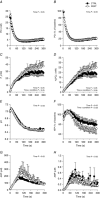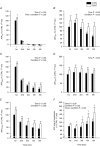Influence of group III/IV muscle afferents on small muscle mass exercise performance: a bioenergetics perspective
- PMID: 29644702
- PMCID: PMC6002240
- DOI: 10.1113/JP275817
Influence of group III/IV muscle afferents on small muscle mass exercise performance: a bioenergetics perspective
Abstract
Key points: This investigation assessed the influence of group III/IV muscle afferents on small muscle mass exercise performance from a skeletal muscle bioenergetics perspective. Group III/IV muscle afferent feedback was attenuated with lumbar intrathecal fentanyl during intermittent isometric single-leg knee-extensor all-out exercise, while 31 P-MRS was used to assess skeletal muscle bioenergetics. Attenuation of group III/IV muscle afferent feedback improved exercise performance during the first minute of exercise, due to an increase in total ATP production with no change in the ATP cost of contraction. However, exercise performance was not altered during the remainder of the protocol, despite a sustained increase in total ATP production, due to an exacerbated ATP cost of contraction. These findings reveal that group III/IV muscle afferents directly limit exercise performance during small muscle mass exercise, but, due to their critical role in maintaining skeletal muscle contractile efficiency, with time, the benefit of attenuating the muscle afferents is negated.
Abstract: The direct influence of group III/IV muscle afferents on exercise performance remains equivocal. Therefore, all-out intermittent isometric single-leg knee-extensor exercise and phosphorous magnetic resonance spectroscopy (31 P-MRS) were utilized to provide a high time resolution assessment of exercise performance and skeletal muscle bioenergetics in control conditions (CTRL) and with the attenuation of group III/IV muscle afferent feedback via lumbar intrathecal fentanyl (FENT). In both conditions, seven recreationally active men performed 60 maximal voluntary quadriceps contractions (MVC; 3 s contraction, 2 s relaxation), while knee-extensor force and 31 P-MRS were assessed during each MVC. The cumulative integrated force was significantly greater (8 ± 6%) in FENT than CTRL for the first minute of the all-out protocol, but was not significantly different for the second to fifth minutes. Total ATP production was significantly greater (16 ± 21%) in FENT than CTRL throughout the all-out exercise protocol, due to a significantly greater anaerobic ATP production (11 ± 13%) in FENT than CTRL with no significant difference in oxidative ATP production. The ATP cost of contraction was not significantly different between FENT and CTRL for the first minute of the all-out protocol, but was significantly greater (29 ± 34%) in FENT than in CTRL for the second to fifth minutes. These findings reveal that group III/IV muscle afferents directly limit exercise performance during small muscle mass exercise, but, due to their critical role in maintaining skeletal muscle contractile efficiency, with time, the benefit from muscle afferent attenuation is negated.
Keywords: intrathecal fentanyl; magnetic resonance spectroscopy; muscle metabolism.
© 2018 The Authors. The Journal of Physiology © 2018 The Physiological Society.
Figures





Similar articles
-
Bioenergetics and ATP Synthesis during Exercise: Role of Group III/IV Muscle Afferents.Med Sci Sports Exerc. 2017 Dec;49(12):2404-2413. doi: 10.1249/MSS.0000000000001391. Med Sci Sports Exerc. 2017. PMID: 28767527 Free PMC article.
-
Identifying the role of group III/IV muscle afferents in the carotid baroreflex control of mean arterial pressure and heart rate during exercise.J Physiol. 2018 Apr 15;596(8):1373-1384. doi: 10.1113/JP275465. Epub 2018 Mar 2. J Physiol. 2018. PMID: 29388218 Free PMC article.
-
Group III/IV muscle afferents limit the intramuscular metabolic perturbation during whole body exercise in humans.J Physiol. 2016 Sep 15;594(18):5303-15. doi: 10.1113/JP272283. Epub 2016 Jul 8. J Physiol. 2016. PMID: 27241818 Free PMC article.
-
A comparison of central aspects of fatigue in submaximal and maximal voluntary contractions.J Appl Physiol (1985). 2008 Feb;104(2):542-50. doi: 10.1152/japplphysiol.01053.2007. Epub 2007 Nov 21. J Appl Physiol (1985). 2008. PMID: 18032577 Review.
-
Are type III-IV muscle afferents required for a normal steady-state exercise hyperpnoea in humans?J Physiol. 2014 Feb 1;592(3):463-74. doi: 10.1113/jphysiol.2013.261925. Epub 2013 Sep 2. J Physiol. 2014. PMID: 24000177 Free PMC article. Review.
Cited by
-
Use of concentric linear velocity to monitor flywheel exercise load.Front Physiol. 2022 Aug 12;13:961572. doi: 10.3389/fphys.2022.961572. eCollection 2022. Front Physiol. 2022. PMID: 36035469 Free PMC article.
-
Passive bilateral leg cycling with concomitant regional circulatory occlusion for testing mechanoreflex-metaboreflex interactions in humans.Clin Auton Res. 2020 Dec;30(6):549-556. doi: 10.1007/s10286-020-00717-x. Epub 2020 Aug 8. Clin Auton Res. 2020. PMID: 32770375 Free PMC article.
-
Lactic acidosis: implications for human exercise performance.Eur J Appl Physiol. 2025 Jul;125(7):1761-1795. doi: 10.1007/s00421-025-05750-0. Epub 2025 Mar 15. Eur J Appl Physiol. 2025. PMID: 40088272 Free PMC article. Review.
-
Exercise intolerance in pulmonary arterial hypertension: insight into central and peripheral pathophysiological mechanisms.Eur Respir Rev. 2021 Apr 13;30(160):200284. doi: 10.1183/16000617.0284-2020. Print 2021 Jun 30. Eur Respir Rev. 2021. PMID: 33853885 Free PMC article. Review.
-
On the Influence of Group III/IV Muscle Afferent Feedback on Endurance Exercise Performance.Exerc Sport Sci Rev. 2020 Oct;48(4):209-216. doi: 10.1249/JES.0000000000000233. Exerc Sport Sci Rev. 2020. PMID: 32658041 Free PMC article. Review.
References
-
- Amann M & Calbet JA (2008). Convective oxygen transport and fatigue. J Appl Physiol 104, 861–870. - PubMed
Publication types
MeSH terms
Substances
Grants and funding
LinkOut - more resources
Full Text Sources
Other Literature Sources
Medical

